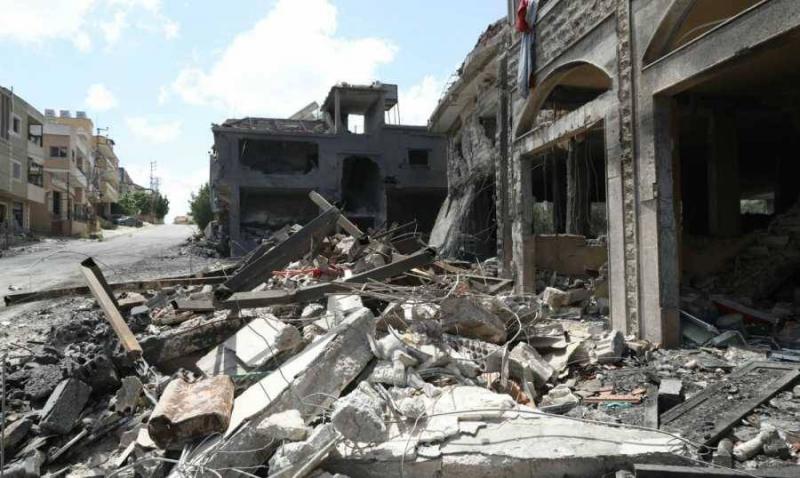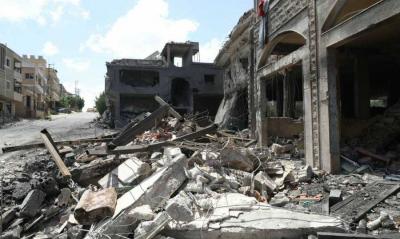The Israeli army has moved to a new phase of military operations in Southern Lebanon, focusing its shelling on the second line of the border area, which is located 7 to 10 kilometers deep, following an initial phase that involved establishing a security perimeter by fire on the first line, which corresponds to towns adjacent to the border, according to "Al-Sharq Al-Awsat."
Notably, the Israeli bombardment has concentrated on the towns of Shuqra, Bar‘ashit, al-Taybah, and the outskirts of Dayr Mimas in the eastern sector, as well as Tair Harfa and Wadi al-Zarqa in the western sector. These towns are not directly on the border with Israel, as the border villages have become almost deserted, suffering extensive destruction of homes and vital facilities. The villages of the second line are located 7 to 10 kilometers from the border, separated from the first line by natural barriers like Wadi al-Hijjar, which divides the area from the eastern to the middle sector into two parts.
While the villages west of Wadi al-Hijjar previously experienced intermittent airstrikes and rare artillery shelling, they have now become targets for artillery and aerial attacks, specifically the villages of Bar‘ashit and Shuqra located on the western shoulder of Wadi al-Hijjar. Heavy artillery shelling has targeted the outskirts of the towns of Hula, Wadi al-Salouqi, and Aytrin, as local media reported on Thursday, following similar attacks on Wednesday that targeted the Shuqra area.
Simultaneously, Israeli forces have intensified their strikes on the second line villages in the western sector, particularly al-Jabayn and Tair Harfa, which have experienced heavy bombardment, along with areas directly on the border such as Alma al-Shab and Yarin, and the outskirts of Naqoura and Hamoul. Local media reported artillery shelling with 155 mm rounds on the outskirts of Naqoura and Alama al-Shab, as well as in the Bateeshia area and outskirts of al-Dhahira, amid reconnaissance and drone flights in the skies. The shelling on Naqoura and Alama al-Shab has led to fires in the forests and olive groves, where civil defense teams have been working to extinguish them. The Israeli army also targeted a house in the border town of Ramya with a guided missile (ground-to-ground).
This shift in bombing comes alongside a change in the types of weapons used by Hezbollah. In addition to the guided missiles it has been launching since the beginning of the war, its use of drones and curved missiles that require a greater range to launch has increased in recent weeks, targeting military sites deeper in Israeli territory, particularly in the occupied Golan Heights and Safad in Upper Galilee, as well as deeper areas in Lower Galilee.
Hezbollah claimed responsibility on Wednesday for an aerial attack using a squadron of suicide drones launched at the newly established command post for the artillery battalion of the 146th division south of Kiryat Shmona, targeting command areas, fire control teams, and artillery positions, inflicting direct casualties among them, according to their statement.
Israeli media reported that a person was critically injured in Kiryat Shmona, located east of Nahariya, due to a drone that penetrated from Lebanon. The Israeli army confirmed that several drones launched from Lebanon fell within Israel on Thursday, while a mayor in the region told Channel 12 that one person was seriously injured. Additionally, the Israeli army stated that, apart from the drones that fell, several suspicious aerial targets tracked from Lebanon towards Israeli territory were intercepted.
The army noted that following alerts activated in the Upper Galilee area in the morning, air defense fighters successfully intercepted several airborne targets headed towards Israel from Lebanese territory. It added that after warnings were activated in the Western Galilee area, several unmanned aerial vehicles were detected crossing Lebanese territory and fell in the Western Galilee area.
Furthermore, Hezbollah announced in two statements that it had shelled two Israeli positions. In the first statement, it was reported that its fighters targeted the newly established intelligence equipment at the Yarin site, achieving a direct hit. The second statement mentioned that its fighters shelled a gathering of Israeli enemy soldiers near the Hanita site with rocket fire, achieving a direct hit, and it also claimed responsibility for targeting the new technical equipment at the Malakiya site, according to "Al-Sharq Al-Awsat."




